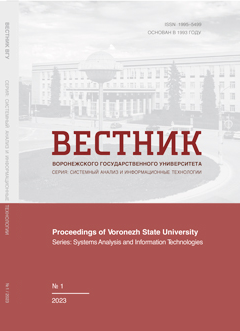Методы применения клеточных автоматов в системах защиты информации
Аннотация
В данной статье проведен обзор автоматных шифраторов, основанных на клеточных автоматах, областью применения которых являются системы защиты информации. Рассмотрены исследования, посвященные вариантам применения клеточных автоматов в системах симметричного шифрования и их практической реализации, а также вариантам построения криптосистем с открытым ключом на основе клеточных автоматов, использованию клеточных автоматов для генерации псевдослучайных чисел, а также исследования, в которых представлены методы построения криптографических хэш-функций с использованием клеточных автоматов. Представлено обобщенное понятие абстрактного автомата и более усовершенствованных моделей клеточных автоматов, проведен сравнительный обзор моделей клеточных автоматов с целевой функцией и клеточных автоматов с плавающим окном, включающий описание алгоритмов их работы и некоторую оценку стойкости. Рассмотрены методы применения клеточных автоматов при многопоточной обработке данных с возможностью применении паттернов, определяющих индивидуальную окрестность элементов при клеточном шифровании, возможностью использования справочника, содержащего набор правил обхода матрицы шифрования, а также метод одноключевого преобразования двоичных потоков данных с открытым параметром на базе клеточного автомата с плавающим окном и динамической матрицей, разделяющейся на элементарные сегменты. Рассмотрена возможность применения клеточных автоматов при многопоточной обработке данных в режиме реального времени. В заключении приведены рекомендации по повышению стойкости методов защиты информации, основанных на клеточных автоматах, одним из которых является метод использования расширенного ключа, определяющего псевдослучайную окрестность, с учетом положения обрабатываемого бита в матрице исходных данных.
Скачивания
Литература
2. Franti E. & Dascalu M. (2021) Cellular Automata Encryption System. In: Topping, B. H. V., Montero, G., Montenegro, R. (eds.) Proceedings of The Fifth International Conference on Engineering Computational Technology. Stirlingshire, Civil-Comp Press. P. 283–297. DOI: 10.4203/ccp. 84.38.
3. Khaleel G., Turaev S., Tamrin M. & Al-Shaikhli imad F. (2016) A New Block Cipher Based on Finite Automata Systems. International Journal on Perceptive and Cognitive Computing. 2 (1). doi: 10.31436/ijpcc.v2i1.31.
4. Kumaresan G. & Gopalan N. (2017) An Analytical Study of Cellular Automata and its Applications in Cryptography. International Journal of Computer Network and Information Security. 12. P. 45–54. DOI: 10.5815/ijcnis.2017.12.06.
5. Zotov Ya. A. (2015) The use of cellular automata in a symmetric cryptosystem. Cybersecurity Issues. 3 (11). P. 43–45.
6. Taimori A. & Marvasti F. (2018) Adaptive Sparse Image Sampling and Recovery. IEEE Transactions on Computational Imaging. 4 (3). P. 311–325. DOI: 10.1109 / TCI.2018.2833625.
7. Hanis S. & Amutha R. (2018) Double image compression and encryption scheme using logistic mapped convolution and cellular automata. Multimed Tools Appl. 77, P. 6897–6912. DOI:10.1007/s11042-017-4606-0.
8. Zhang F., Chen X. & Zhang X. (2020) Parallel thinning and skeletonization algorithm based on cellular automaton. Multimedia Tools and Applications. 79 (12). DOI: 10.1007 / s11042-020-09660-5.
9. Roy S., Rawat U., Sareen H. & Nayak S. (2020) IECA: an efficient IoT friendly image encryption technique using programmable cellular automata. J Ambient Intell Human Comput. 11. P. 5083–5102. DOI: 10.1007/s12652-020-01813-6.
10. Klyucharyov P. G. (2012) Block ciphers based on generalized cellular automata. Science and education: electronic scientific and technical publication. 12. P. 235–246. DOI: 10.7463/0513.0574231.
11. Mehta R. K. & Rani R. (2016) Pattern generation and symmetric key block ciphering using cellular automata. Proceedings of the International Conference on Advances in Computing, Communications and Informatics (ICACCI 2016), Jaipur, India. P. 2692–2695. DOI: 10.1109/ICACCI.2016.7732467.
12. Lira E., Macêdo H., Lima D., Alt L. & Oliveira G. (2021). A reversible system based on hybrid toggle radius-4 cellular automata and its application as a block cipher. Natural Computing. 2. P. 1–34.
13. Achkoun, K., Hanin, C. & Omary, F. (2019) SPF-CA: A new cellular automata based block cipher using key-dependent S-boxes. Journal of Discrete Mathematical Sciences and Cryptography. 23. P. 1–16. DOI: 10.1080/09720529.2019.1649031.
14. Achkoun K., Hanin C., Sadak A., Ziani F. E. & Omary F. (2021) SPF-CA-1.2: An enhanced version of cellular automata based block cipher system. International Journal of Computer Mathematics: Computer Systems Theory. 6 (2). P. 1–17. DOI: 10.1080/23799927.2021.1942991.
15. Klyucharyov P. G. (2016) On the performance of block ciphers based on cellular automata when they are implemented on graphic processors. J. Radio optics. 6. P. 24–34. DOI: 10.7463/rdopt.0616.0850899.
16. Tanasyuk Y. & Burdeinyi P. (2020) Block ciphers on the basis of reversible cellular automata. Informatyka, Automatyka, Pomiary W Gospodarce I Ochronie Środowiska. 10. P. 8–11. DOI: 10.35784/iapgos.919.
17. Kari J. (1994) Reversibility and surjectivity problems of cellular automata. Journal of Computer and System Science. 1 (48). P. 149–182.
18. Clarridge A. & Salomaa K. (2009) A Cryptosystem Based on the Composition of Reversible Cellular Automata. In: Dediu, A. H., Ionescu, A. M., Martín-Vide, C. (eds.) Language and Automata Theory and Applications, LATA 2009. LNCS, vol 5457. Springer, Berlin, Heidelberg. P. 314–325. DOI: 10.1007/978-3-642-00982-2_27.
19. Zhu B.-P., Zhou L. & Liu F.-Y. (2007) Public-key cryptosystem based on cellular automata. Journal of Nanjing University of Science and Technology. 31. P. 612–616.
20. Sukhinin B. M. (2010) High-speed pseudorandom sequence generators based on cellular automata. Prikl. Diskr. Mat. 8 (2). P. 34–41.
21. Bogachenko N. F. & Gorokhov I. O. (2020) Construction of a pseudo-random sequence generator based on a cellular automaton. Mathematical structures and modeling. 4 (56). P. 64–74. DOI: 10.24147/2222-8772.2020.4.64-74.
22. Mukhamedzhanov D. D. & Levin A. B. (2018) Pseudo-random number generator based on cellular automata. Scientific and technical bulletin of information technologies, mechanics and optics. 5 (18). P. 894–900. DOI: 10.17586/2226-1494-2018-18-5-894-900.
23. Lanskikh V. G., Titova N. A., Kashina E. V. & Peshnina L. V. (2018) Investigation of generators of pseudo-random binary numbers based on inhomogeneous cellular automata with a pseudo-random choice of interaction rules. J. IT Arctic. 3. P. 55–68.
24. Klyucharyov P. G. (2017) Method for constructing cryptographic hash functions based on iterations of a generalized cellular automaton. Cybersecurity Issues. 1 (19). P. 45–50. DOI: 10.21581/2311-3456-2017-1-45-50.
25. Alaa E. B. & Kamel M. F. (2015) Building Secure and Fast Cryptographic Hash Functions Using Programmable Cellular Automata. Journal of Computing and Information Technology. 4. P. 317–328. DOI: 10.2498/cit.1002639.
26. Rajeshwaran K. & Anil Kumar K. (2019) Cellular Automata Based Hashing Algorithm (CABHA) for Strong Cryptographic Hash Function. Proceedings of the IEEE International Conference on Electrical, Computer and Communication Technologies (ICECCT 2019), Coimbatore, India. P. 1–6. DOI: 10.1109/ICECCT.2019.8869146.
27. Slimane N., Aouf N., Bouallegue K. & Machhout M. (2018) Hash Key-Based Image Cryptosystem Using Chaotic Maps and Cellular Automata. Proceedings of the IEEE 15th International Multi-Conference on Systems, Signals & Devices (SSD), Yasmine Hammamet, Tunisia. P. 190–194. DOI: 10.1109/SSD.2018.8570644.
28. Dobritsa V. P., Zarubin D. M., Zarubina N. K. & Nozdrina A. A. (2016) Sequential automatic encoders. Bulletin of the Southwest State University. 1 (18). P. 36–39.
29. Rososhek S. K., Borovkov S. I. & Evsyutin O. O. Cryptosystems of cellular automata. Applied discrete mathematics. 1. P. 43–49.
30. Zarubin D. M., Dobritsa V. P. & Shein E. V. (2017) Improvement of a cellular automaton with a target function to increase resistance. In: Andronov, V. G. (eds.) 1st All-Russian Scientific and Practical Conference: Proceedings of the Infocommunications and space technologies: state, problems and solutions, Kursk, Russia. P. 227–231.
31. Dobritsa V. P., Efremov M. A., Zarubin D. M. & Asyutikov A. A. (2017) Improvement of a cellular automaton on a partition for increasing. In: Andronov, V. G. (eds.) 1st All-Russian Scientific and Practical Conference: Proceedings of the Infocommunications and space technologies: state, problems and solutions, Kursk, Russia. P. 224–227.
32. Asutikov A. A. & Dobritsa V. P. (2018) Encryption by a cellular automaton on a partition according to the floating window principle. In: Andronov, V. G. (eds.) 2nd All-Russian Scientific and Practical Conference: Proceedings of the Infocommunications and space technologies: state, problems and solutions, Kursk, Russia. P. 45–50.
33. Kuleshova E. A., Marukhlenko A. L., Dobritsa V. P. & Tanygin M. O. (2019) Multi-threaded data processing system based on cellular automata. Proceedings of the 11th Majorov International Conference on Software Engineering and Computer Systems (MICSECS 2019), Saint Petersburg. P. 1–12.
34. Marukhlenko A. L., Plugatarev A. V., Tanygin M. O., Marukhlenko L. O. & Bobintsev D. O. (2019) Variant of organizing multithreaded processing of confidential data based on cellular automata. Bulletin of the Southwest State University. 3 (23). P. 100–112.
35. Kuleshova E. A., Marukhlenko A. L., Dobritsa V. P. & Tanygin M. O. (2020) Formation of Unique Characteristics of Hiding and Encoding of Data Blocks Based on the Fragmented Identifier of Information Processed by Cellular Automata. Computers. 9 (51). DOI: 10.3390/computers9020051.
Copyright (c) 2021 Елена Александровна Кулешова

Это произведение доступно по лицензии Creative Commons «Attribution» («Атрибуция») 4.0 Всемирная.
- Авторы сохраняют за собой авторские права и предоставляют журналу право первой публикации работы, которая по истечении 6 месяцев после публикации автоматически лицензируется на условиях Creative Commons Attribution License , которая позволяет другим распространять данную работу с обязательным сохранением ссылок на авторов оригинальной работы и оригинальную публикацию в этом журнале.
- Авторы имеют право размещать их работу в сети Интернет (например в институтском хранилище или персональном сайте) до и во время процесса рассмотрения ее данным журналом, так как это может привести к продуктивному обсуждению и большему количеству ссылок на данную работу (См. The Effect of Open Access).


















